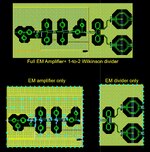anh56789
Junior Member level 1

Hi everyone,
I'm working on my thesis about a beamformer system using CMOS 65nm technology. I am using the EM simulator from ADS software with the Momentum microwave engine. However, my EM layout is quite large, and the calculated mesh is extremely detailed, making it difficult to simulate the full system. As a result, I have to divide the system into smaller parts and simulate each part individually.
I have attached a snapshot of my setup, which includes an amplifier and a 1-to-2 Wilkinson power divider. I have separated them and placed pins to facilitate EM simulations for each circuit. Additionally, I have placed ground pins at the boundaries of each circuit to connect to the ground plane.
I have a couple of questions:
I'm working on my thesis about a beamformer system using CMOS 65nm technology. I am using the EM simulator from ADS software with the Momentum microwave engine. However, my EM layout is quite large, and the calculated mesh is extremely detailed, making it difficult to simulate the full system. As a result, I have to divide the system into smaller parts and simulate each part individually.
I have attached a snapshot of my setup, which includes an amplifier and a 1-to-2 Wilkinson power divider. I have separated them and placed pins to facilitate EM simulations for each circuit. Additionally, I have placed ground pins at the boundaries of each circuit to connect to the ground plane.
I have a couple of questions:
- Is breaking the circuit into smaller pieces a valid approach? I believe this method may work at lower frequencies, but I am concerned that higher frequencies could lead to coupling effects that might create discrepancies. Since the layout includes a large ground plane, the mesh for this ground plane is also substantial, complicating EM simulations. Do you know of any methods that could help me address this issue?
- Regarding the ground pins around these circuits, I have noticed that the number of pins can significantly affect the simulation results. I am confused about why this happens. Can you provide any insights on this?

